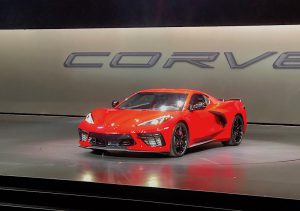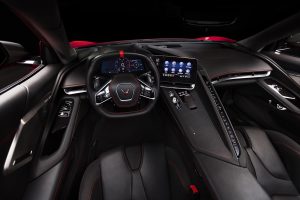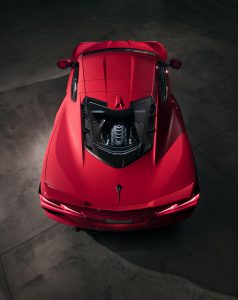(This story has been updated to include pricing information on the new Corvette Stingray.)
“It’s the stuff dreams are made of,” or so the fictional detective Sam Spade might have said, had he been a fan of the Chevrolet Corvette.
For more than 50 years, Chevy has been tinkering with the idea of creating a mid-engine ‘Vette, all the way back to the days of Zora Arkus-Duntov, the man often referred to as the “father” of “America’s sports car.” But, despite working out plans on paper, and even creating a number of prototypes, the concept has never come to fruition. Not until now, however. But with the C8, the mid-engine Corvette is finally set to become a reality.
The car that was revealed during a Standing Room Only event near Los Angeles on Thursday night, is, if anything, just the first step in a roll-out that will be staggered over the coming years. Chevy will start with the launch of the 2020 Corvette Stingray, but plenty of other variants, including familiar upgrades like the Z06 and ZR1 are yet to follow, and sources have told TheDetroitBureau.com that the automaker is even preparing electrified variants that are as dramatic a transformation as the move to a mid-engine layout.
(The new Corvette C8 borrows an old name. When did Stingray first get used? Click Here to find out.)
The C8 program very nearly didn’t come to pass. In fact, there was a time, a little more than a decade ago, when it seemed the Corvette, in any form, might vanish.
By the time the new millennium began, it became obvious that some dramatic changes were needed to keep the Corvette competitive. The sports car’s development team convinced Bob Lutz, then the General Motors car czar, to back the shift from front to mid-engine. In turn, he won the approval of former GM Chairman and CEO Rick Wagoner. But then things started to fall apart.
“The traditional front-engine vehicle reached its limits of performance,” said GM Pres. Reuss.
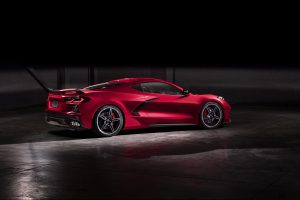
The underlying architecture of the C8 will allow Corvette engineers to adopt a variety of different powertrains.
As the recession hit, GM’s finances began to fall apart and the automaker started to slash product development programs, especially those that didn’t seem critical. Funding for Corvette was halted. It didn’t help. The automaker plunged into Chapter 11, rescued only by a managed bankruptcy process and a massive government bailout.
The shutdown hit during the middle of work on the seventh-generation ‘Vette. “That version almost didn’t happen,” recalled Tom Peters, the chief designer on the seventh-generation sports car. But Peters and much of the rest of the Corvette team refused to give up. Quietly, they kept working on the program in their off hours until GM emerged from Chapter 11 and could free up funding again – something the post-bankruptcy management team came to support once they realized that a Corvette can generate more than $20,000 in profits, even more than the Chevy Silverado pickup.
Ironically, said Tadge Juechter, the chief engineer on both the sports car that came out in 2014 and the new C8, “It was a better car for the delay,” the team having more time – and, eventually, money – to do it right.
But while some had originally hoped the C7 would be the first to go mid-engine, it stuck with the traditional Corvette formula. Major changes would have to wait until the next model, and work began even before the new, 2014 model reached showrooms.
“The traditional front-engine vehicle reached its limits of performance, necessitating the new layout,” explained GM President Mark Reuss ahead of the C8 unveiling Thursday night. “In terms of comfort and fun, it still looks and feels like a Corvette, but drives better than any vehicle in Corvette history.”
Visually, there are some familiar cues with the 2020 Chevrolet Corvette, like the sculpting of the hood, the taillights, the shape of the doors, that harken back to the C7. But this is a radically different beast. The overall look, with its short nose and long midsection, is likely to trigger comparisons to some of the latest European supercars, such as McLaren.
The new C8 actually grows longer, wider and 366 pounds heavier than the C7, or seventh-generation Corvette. But a driver might not notice, with a hood that almost disappears from view when you’re in the left seat. The seats are now more than 16 inches closer to the front, in fact, since there’s nothing but a small “frunk” in front.
Inside, the Corvette gets a much more driver-oriented layout, with a squared-off steering wheel providing a clear view of the new, reconfigurable instrument cluster. The infotainment system, as well, has been angled towards the driver and provides an array of vehicle performance information, as well as audio and navigation displays. And a number of key controls will line up in a column running along the outer edge of the center console, a layout some might find reminiscent of Porsche.
Buyers, meanwhile, will have the option of three different seating packages, including a Competition Sport package that, Chevy says, uses Napa leather trim and “an all-new durable performance textile inspired by Kevlar vests.”
The heart of the beast is, at least with the 2020 Chevrolet Corvette Stingray, a new version of Chevrolet’s 6.2-litre Small Block LT2 V-8 engine – the only naturally aspirated eight-banger in the segment, in fact. Engine output is rated at 495 horsepower and 470 pound-feet of torque, 40 hp and 10 lb-ft more than the outgoing sports car.
The engine is not only more powerful but a treat to look at – so much so that Chevy has put it in clear view, thanks to a 3.2 mm glass cover.
The C8 platform “will last for a long time,” and that means “a lot of variants,” reports veteran journalist Don Sherman.
Among the changes to the LT2 update, there’s a dry sump – the first for a base Corvette – with three scavenge pumps for improved track performance. There’s also a 25% increase in oil cooler capacity.
Notably, this will be the first time since a brief period in 1982 when a Corvette will come to market without a manual gearbox option. The C8 packages an all-new eight-speed dual-clutch transaxle. The system will use new algorithms “to sense when you’re doing spirited driving,” according to Chief Engineer Juechter, though paddle shifters will allow manual operation, and a new double-paddle de-clutch feature will allow the driver to decouple the clutch for even greater manual control.
As with the C7, the new Stingray will offer buyers Magnetic Ride Control, which uses a special, magnetically sensitive fluid that allows dampers to be adjusted anywhere from soft to hard in the time it takes to travel two inches at 60 mph. A performance traction management system is also on the option list, but the “base” car features an electronic limited slip differential. And a paired front splitter and open two-piece rear spoiler adds as much as 400 pounds of downforce under aggressive cornering.
Buyers will have the option of all-season Michelin Pilot Sport ALS tires – which Chevy claims can manage nearly 1G cornering – or the Z51 package’s Michelin Pilot Sport 4S. Front tires are 245/35ZR19s, with 305/30ZR20s in the rear.
What does all this accomplish? Chevrolet is promising 0 to 60 times of “less than” three seconds, making the C8 both the fastest and most powerful “base” Corvette ever.
But, as with today’s outgoing model, the bowtie brand knows buyers are likely to be asking for more, possible lots more, power. According to Don Sherman, the veteran Detroit auto journalist, who has spent decades tracking the on-off-on progress of the mid-engine Corvette program, the underlying C8 platform “will last for a long time,” and that means “a lot of variants” have been factored into the planning.
For one thing, the initial coupe version of the 2020 Corvette will soon be followed by a convertible.
(Hold your horses! Shelby GT 500 cracks the 700 hp barrier. Click Here to check it out.)
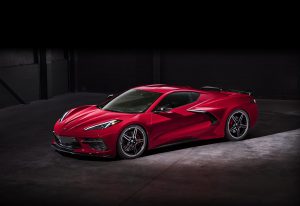
There are clear hints of classic Corvettes, but the C8 adopts a much more global look and the mid-engine design is unmistakable.
You also can expect to see some familiar names, like Z06 and ZR1. The latter, currently the ultimate version of the C7 generation, is turning out an impressive 755 horsepower. But in an era when cross-town competitors are nudging that figure with models like the Dodge SRT Challenger Hellcat and the Ford Shelby GT500 – and where many extreme machines are pushing into four-figure territory – Chevy seems determined to press well beyond where it is now.
Could a 1,000 horsepower Corvette be in the cards? For one thing, consider this: the new platform has been engineered “to allow a wide variety of powertrains,” a senior member of the program told TheDetroitBureau.com. No, you won’t see a V-12, but electrification is one of the options that the C8 team has reserved for.
“This will get people to give Corvette a new look,” says auto historian Ken Gross.
Precisely what form of battery-drive system? That’s where lips were sealed, but we were told “We would not look stupid” speculating that one likely option would see Corvette go with a mild hybrid system that could add 100 pound-feet or more of torque upon launch, shaving even more launch time. Other likely scenarios include a plug-in hybrid package and an all-wheel-drive system that would have the front axle powered by an electric motor.
That approach, according to journalist Sherman, would be modeled after the current Acura NSX which uses its twin-turbo V-6 to power the rear wheels, two separate motors powering the front wheels, a layout that enhances torque vectoring capabilities.
With the debut of the C8, Chevrolet wants “America’s sports car” to become a true world-beater for the first time.
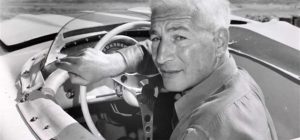
Zora Arkus-Duntov, “the father of the Corvette,” dreamed of doing a mid-engine version over a half-century ago,
As to a fully electric package? That is possible, perhaps sharing one of the all-electric drive systems that will be used by Chevy’s sibling Cadillac brand. The problem is that the underlying architecture of the C8 was not designed to have batteries mounted under the floorboard. That could be accomplished, our sources said, but would raise the vehicle’s height.
Whichever approach eventually rolls out, the 2020 Chevrolet Corvette Stingray is destined to just be the first of a much broader line-up of variants coming to showrooms over the next few years. And not just U.S. dealer lots.
There’s no question that GM wants to transform “America’s sports car” into a global competitor. It has won some non-traditional fans with a price tag well below that of competitors like Porsche, never mind Ferrari or McLaren. The ultimate version of today’s ‘Vette, the ZR1, comes in around $120,000, the starting price of the 911.
In a surprise move, GM President Reuss announced that the starting price for the 2020 Chevrolet Corvette will be “under $60,000.” A final figure won’t be available until closer to its upcoming on-sale date, however.
(2,000 hp, 200 mph, $2 mil. Click Here to check out the new, all-electric Lotus Evija.)
China is certainly one place where GM sees a potentially significant outlet. Buyers there have already embraced Ford’s Mustang. Europe could prove harder. GM sold off its German-based Opel subsidiary several years ago and retains only a modest distribution network for imports like Cadillac and the Corvette on the Continent.
“This will get people to give Corvette a new look,” said author and automotive historian Ken Gross, though he cautioned that Chevrolet doesn’t “have the distribution or the reputation” of key competitors outside the U.S. “It will have to be a truly great car” for the 2020 model to become a truly global icon.
On paper – and now, in person, the C8 certainly looks up to the role it is being given. We’ll have to wait for a chance to drive it, however, to see if it really meets admittedly high expectations.

